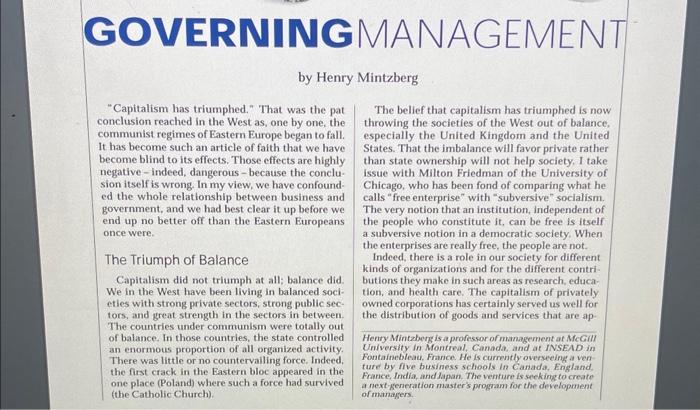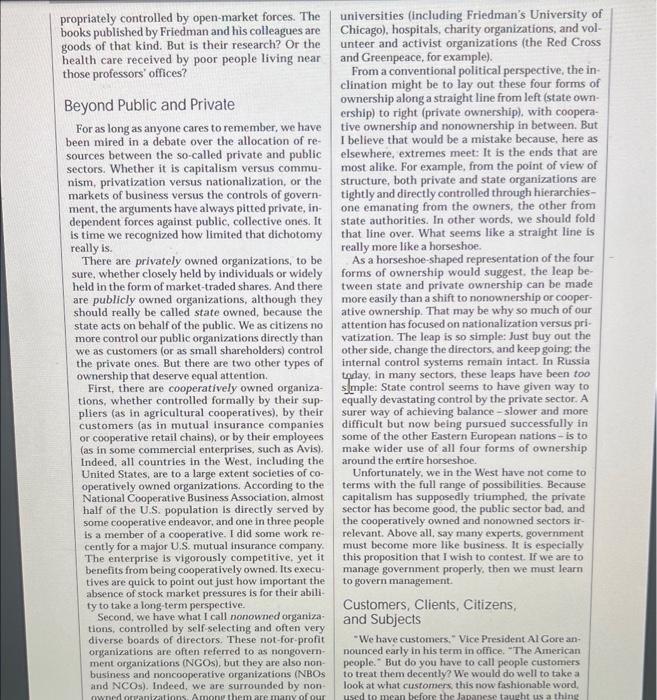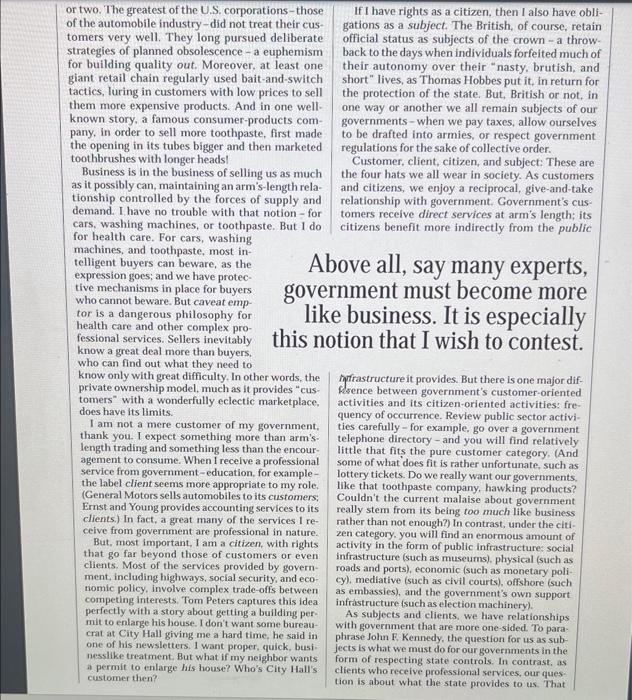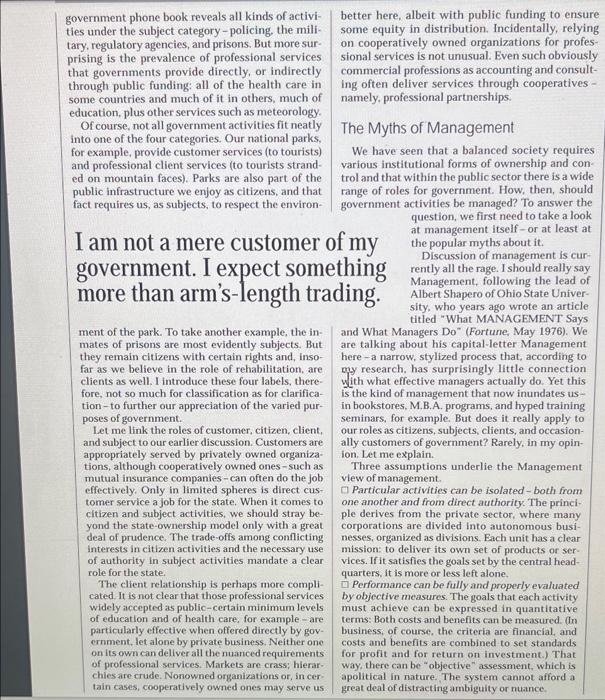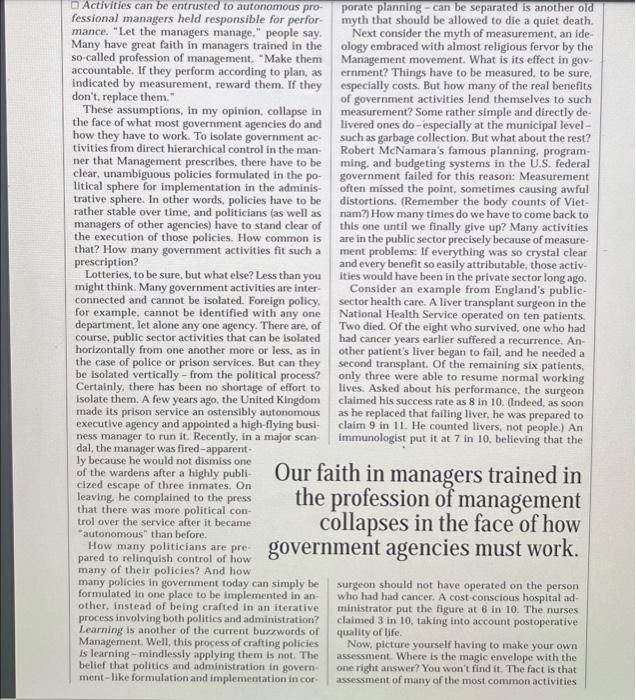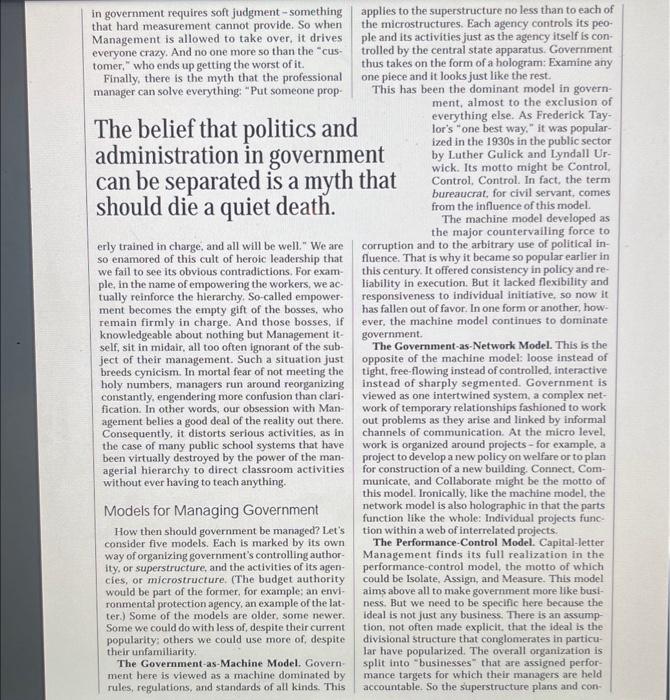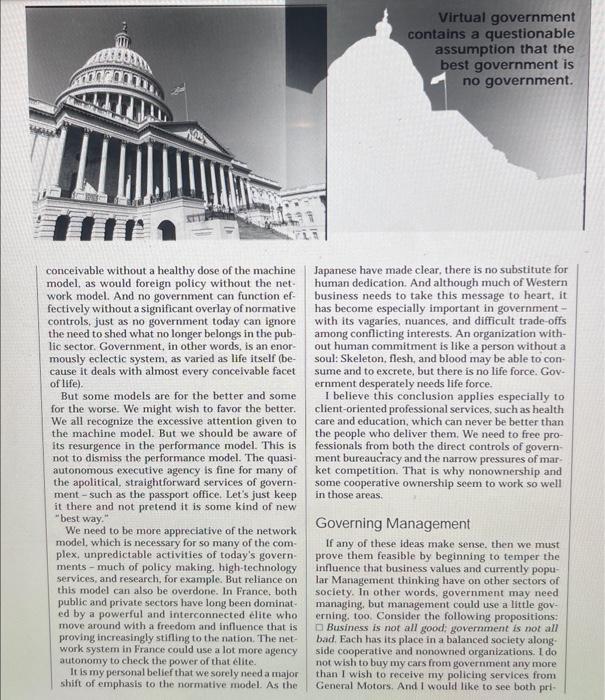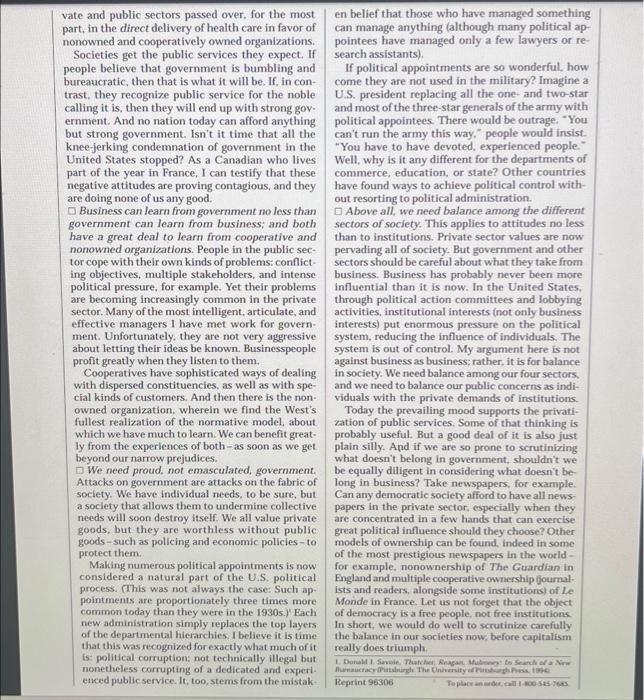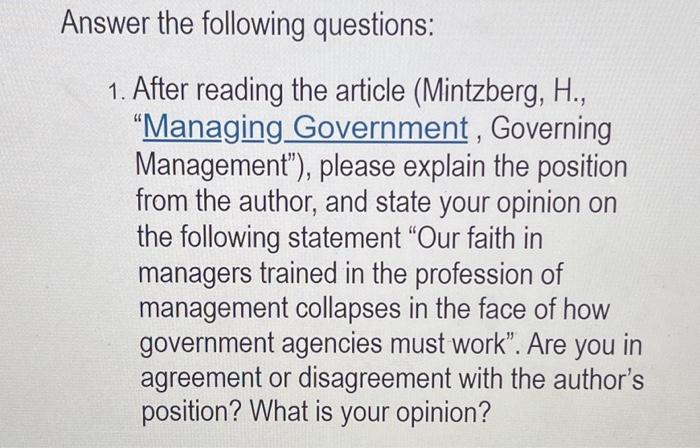"Capitalism has triumphed." That was the pat _ The belief that capitalism has triumphed is now conclusion reached in the West as, one by one, the throwing the societies of the West out of balance, communist regimes of Eastern Europe began to fall. especially the United Kingdorn and the United It has become such an article of fafth that we have States. That the imbalance will favor private rather become blind to its effects. Those effects are highly than state ownership will not help society. I take negative - indeed, dangerous - because the conclu- issue with Milton Friedman of the University of sion itself is wrong. In my view, we have confound- Chicago, who has been fond of comparing what he ed the whole relationship between business and calls "free enterprise" with "subversive" socialism. government, and we had best clear it up before we The very notion that an institution, independent of end up no better off than the Eastern Europeans the people who constitute it, can be free is itself once were. a subversive notion in a democratic society. When The Triumph of Balance Indeed, there is a role in our society for different kinds of organizations and for the different contri. Capitalism did not triumph at all; balance did. butions they make in such areas as research, educaWe in the West have been living in balanced soci- tion, and health care. The capitalism of privately eties with strong private sectors, strong public sec- owned corporations has certainly served us well for tors, and great strength in the sectors in between. the distribution of goods and services that are apThe countries under communism were totally out of balance. In those countries, the state controlled Henry Mintaberg is a professor of management at McGill an enormous proportion of all organized activity. Umiversity in Montreal, Canada, and at INSEAD in There was little or no countervailing force. Indeed. Fontainebleau. Finnice. He is currently overseeing a ven the first crack in the Eastern bloc appeared in the ture by five business schools in Canada, England one place (Poland) where such a force had survived (the Catholic Church). propriately controlled by open-market forces. The | universities (including Friedman's University of books published by Friedman and his colleagues are Chicago), hospitals, charity organizations, and volgoods of that kind. But is their research? Or the unteer and activist organizations (the Red Cross health care received by poor people living near and Greenpeace, for example). those professors' offices? From a conventional political perspective, the inclination might be to lay out these four forms of Beyond Public and Private ownership along a straight line from left (state own. ership) to right (private ownership), with cooperabeen mired in a debate oyer the allocr, we have tive ownership and nonownership in between. But sectors. Whether it is capitalism vers and public elsewhere, extremes meet: It is the ends that are nism, privatization versus nationalization, or the most alike. For example, from the point of view of markets of business versus the controls of govern- . structure, both private and state organizations are ment, the arguments have always pitted private, in- tightly and directly controlled through hierarchiesdependent forces against public, collective ones. It one emanating from the owners, the other from state authorities. In other words, we should fold that line over. What seems like a straight line is There are privately owned organizations, to be really more like a horseshoe. As a horseshoe-shaped representation of the four sure, whether closely held by individuals or widely forms of ownership would suggest, the leap beheld in the form of market-traded shares. And there tween state and private ownership can be made are publicly owned organizations, although they more easily than a shift to nonownership or coopershould really be called state owned, because the ative ownership. That may be why so much of our state acts on behalf of the public. We as citizens no attention has focused on nationalization versus primore control our public organizations directly than vatization. The leap is so simple: Just buy out the we as customers (or as small shareholders) control other side, change the directors, and keep going: the the private ones. But there are two other types of internal control systems remain intact. In Russia ownership that deserve equal attention. today, in many sectors, these leaps have been too First, there are cooperatively owned organiza- s mple: State control seems to have given way to tions, whether controlled formally by their sup- equally devastating control by the private sector. A pliers (as in agricultural cooperatives), by their surer way of achieving balance-slower and more customers (as in mutual insurance companies difficult but now being pursued successfully in or cooperative retail chains), or by their employees some of the other Eastern European nations - is to (as in some commercial enterprises, such as Avis). make wider use of all four forms of ownership Indeed, all countries in the West, including the around the ertire horseshoe. United States, are to a large extent societies of co- Unfortunately, we in the West have not come to operatively owned organizations. According to the terms with the full range of possibilities. Because National Cooperative Business Association, almost capitalism has supposedly triumphed, the private half of the U.S. population is directly served by sector has become good, the public sector bad, and some cooperative endeavor, and one in three people the cooperatively owned and nonowned sectors iris a member of a cooperative. I did some work re- relevant. Above all, say many experts, government cently for a major U.S. mutual insurance company. must become more like business. It is especially The enterprise is vigorously competitive, yet it this proposition that I wish to contest. If we are to benefits from being cooperatively owned. Its execu- manage government properly, then we must learn tives are quick to point out just how important the to govern management. absence of stock market pressures is for their ability to take a long-term perspective. Customers, Clients, Citizens, Second, we have what I call nonowned organiza. and Subjects tions, controlled by self-selecting and often very diverse boards of directors. These not-for-profit "We have customers, Vice President Al Gore anorganizations are often referred to as nongovern- nounced early in his term in office. "The American ment organizations (NGOs), but they are also non- people." But do you have to call people customers business and noncooperative organizations (NBOs to treat them decently? We would do well to take a and NCOs), Indeed, we are surrounded by non- look at what customers, this now fashionable word, or two. The greatest of the U.S, corporations-those If I have rights as a citizen, then I also have obliof the automobile industry-did not treat their cus- gations as a subject. The British, of course, retain tomers very well. They long pursued deliberate official status as subjects of the crown - a throwstrategies of planned obsolescence - a euphemism back to the days when individuals forfeited much of for building quality out. Moreover, at least one their autonomy over their "nasty, brutish, and giant retail chain regularly used bait-and-switch short" lives, as Thomas Hobbes put it, in return for tactics, luring in customers with low prices to sell the protection of the state. But, British or not, in them more expensive products. And in one well- one way or another we all remain subjects of our known story, a famous consumer-products com- governments - when we pay taxes, allow ourselves pany, in order to sell more toothpaste, first made to be drafted into armies, or respect government the opening in its tubes bigger and then marketed regulations for the sake of collective order. toothbrushes with longer heads! Customer, client, citizen, and subject: These are Business is in the business of selling us as much the four hats we all wear in society. As customers as it possibly can, maintaining an arm's-length rela- and citizens, we enjoy a reciprocal, give-and-take tionship controlled by the forces of supply and relationship with government. Government's cusdemand. I have no trouble with that notion - for tomers receive direct services at arm's length; its cars, washing machines, or toothpaste. But 1 do citizens benefit more indirectly from the public for health care. For cars, washing machines, and toothpaste, most intelligent buyers can beware, as the expression goes; and we have protective mechanisms in place for buyers who cannot beware. But caveat emptor is a dangerous philosophy for health care and other complex professional services. Sellers inevitably this notionthat I wish to contest. know a great deal more than buyers. who can find out what they need to know only with great difficulty. In other words, the iffrastructure it provides. But there is one major difprivate ownership model, much as it provides "cus- fsence between government's customer-oriented tomers" with a wonderfully eclectic marketplace, activities and its citizen-oriented activities: fredoes have its limits. l quency of occurrence. Review public sector activiI am not a mere customer of my government. ties carefully -for example, go over a government thank you. I expect something more than arm's. telephone directory - and you will find relatively length trading and something less than the encour- little that fits the pure customer category, (And agement to consume. When I recelve a professional some of what does fit is rather unfortunate, such as service from government-education, for example - lottery tickets. Do we really want our governments. the label client seems more appropriate to my role. like that toothpaste company, hawking products? (General Motors sells automobiles to its customers; Couldn't the current malaise about government Ernst and Young provides accounting services to its really stem from its being too much like business clients.) In fact, a great many of the services 1 re- rather than not enough?) In contrast, under the citiceive from government are professional in nature. zen category. you will find an enormous amount of But, most important, I am a citizen, with rights activity in the form of public infrastructure: social that go far beyond those of customers or even infrastructure (such as museums). physical (such as clients. Most of the services provided by govern- roads and ports), economic (such as monetary poliment, including highways, social security, and eco- cy), mediative (such as civil courts), offshore (such nomic policy, involve complex trade-offs between as embassies), and the government's own support competing interests. Tom Peters captures this idea isfrastructure (such as election machinery). perfectly with a story about getting a building per- As subjects and clients, we have relationships mit to enlarge his house. I don't want some bureau- with government that are more one-sided. To paracrat at City Hall giving me a hard time, he said in phrase John F. Kennedy, the question for us as subone of his newsletters. I want proper, quick, busi. jects is what we must do for our governments in the nesslike treatment. But what if my neighbor wants form of respecting state controls. In contrast, as a permit to enlarge his house? Who's City Hall's clients who receive professional services, our quescustomer then? tion is about what the state provides to us. That government phone book reveals all kinds of activi- better here, albeit with public funding to ensure ties under the subject category-policing, the mili- some equity in distribution. Incidentally, relying tary. regulatory agencies, and prisons. But more sur- on cooperatively owned organizations for profesprising is the prevalence of professional services sional services is not unusual. Even such obviously that governments provide directly, or indirectly commercial professions as accounting and consultthrough public funding: all of the health care in ing often deliver services through cooperatives some countries and much of it in others, much of namely, professional partnerships. education, plus other services such as meteorology. Of course, not all government activities fit neatly The Myths of Management into one of the four categories. Our national parks. for example, provide customer services (to tourists) We have seen that a balanced society requires and professional client services (to tourists strand- various institutional forms of ownership and coned on mountain faces). Parks are also part of the trol and that within the public sector there is a wide public infrastructure we enjoy as citizens, and that range of roles for government. How, then, should fact requires us, as subjects, to respect the environ- government activities be managed? To answer the question, we first need to take a look T. at management itself-or at least at Im not a mere customer of my the popular myths about it. oovernment. I expect SOmething Discussion of management is curSOveInment. I expecLsOIIELIIIg lently all the rage. I should really say more than arm's--ength trading. AlbertShaperoofOhioStateUniver-sity,whoyearsagowroteanarticle titled "What MANAGEMENT Says ment of the park. To take another example, the in- | and What Managers Do- (Fortune, May 1976). We mates of prisons are most evidently subjects. But are talking about his capital-letter Management they remain citizens with certain rights and, inso- here - a narrow, stylized process that, according to far as we believe in the role of rehabilitation, are my research, has surprisingly little connection clients as well. I introduce these four labels, there- With what effective managers actually do. Yet this fore, not so much for classification as for clarifica- is the kind of management that now inundates ustion - to further our appreciation of the varied pur- in bookstores, M. B.A. programs, and hyped training Let me link the roles of customer, citizen, client, our roles as citizens, subjects, clients, and occasionand subject to our earlier discussion. Customers are ally customers of government? Rarely, in my opinappropriately served by privately owned organiza- ion. Let me explain. tions, although cooperatively owned ones-such as Three assumptions underlie the Management mutual insurance companies - can often do the job view of management. effectively. Only in limited spheres is direct cus- Particular activities can be isolated -both from tomer service a job for the state. When it comes to one another and from direct authority. The princicitizen and subject activities, we should stray be- ple derives from the private sector, where many yond the state-ownership model only with a great corporations are divided into autonomous busideal of prudence. The trade-offs among conflicting nesses, organized as divisions. Each unit has a clear interests in citizen activities and the necessary use mission: to deliver its own set of products or serof authority in subject activities mandate a clear vices. If it satisfies the goals set by the central headrole for the state. quarters, it is more or less left alone. The client relationship is perhaps more compli- Performance can be fully and properly evaluated cated. It is not clear that those professional services by objective measures. The goals that each activity widely accepted as public-certain minimum levels must achieve can be expressed in quantitative of education and of health care, for example - are terms: Both costs and benefits can be measured. (in particularly effective when offered directly by gov- business, of course, the criteria are financial, and ernment, let alone by private business. Neither one costs and benefits are combined to set standards on its own can deliver all the nuanced requirements for profit and for return on investment.) That of professional services. Markets are crass; hierar- way, there can be "objective" assessment, which is chies are crude. Nonowned organizations or, in cer: apolitical in nature. The system cannot afford a tain cases, cooperatively owned ones may serve us great deal of distracting ambiguity or nuance Activities can be entrusted to autonomous pro- porate planning - can be separated is another old fessional managers held responsible for perfor- myth that should be allowed to die a quiet death. mance. "Let the managers manage," people say. Next consider the myth of measurement, an ideMany have great faith in managers trained in the ology embraced with almost religious fervor by the so-called profession of management. "Make them Management movement. What is its effect in govaccountable. If they perform according to plan, as ernment? Things have to be measured, to be sure, indicated by measurement, reward them. If they especially costs. But how many of the real benefits don't, replace them." of government activities lend themselves to such These assumptions, in my opinion, collapse in measurement? Some rather simple and directly dethe face of what most government agencies do and livered ones do-especially at the municipal levelhow they have to work. To isolate government ac- such as garbage collection. But what about the rest? tivities from direct hierarchical control in the man- Robert McNamara's famous planning, programner that Management prescribes, there have to be ming, and budgeting systems in the U.S. federal clear, unambiguous policies formulated in the po- government failed for this reason: Measurement litical sphere for implementation in the adminis- often missed the point, sometimes causing awful trative sphere. In other words, policies have to be distortions. (Remember the body counts of Vietrather stable over time, and politicians (as well as nam?) How many times do we have to come back to managers of other agencies) have to stand clear of this one until we finally give up? Many activities the execution of those policies. How common is are in the public sector precisely because of measurethat? How many government activities fit such a ment problems: If everything was so crystal clear prescription? and every benefit so easily attributable, those activLotteries, to be sure, but what else? Less than you ities would have been in the private sector long ago. might think. Many government activities are inter- Consider an example from England's publicconnected and cannot be isolated. Foreign policy. sector health care. A liver transplant surgeon in the for example, cannot be identified with any one National Health Service operated on ten patients. department, let alone any one agency. There are, of Two died. Of the eight who survived, one who had course, public sector activities that can be isolated had cancer years earlier suffered a recurrence. Anhorizontally from one another more or less, as in other patient's liver began to fail, and he needed a the case of police or prison services. But can they second transplant. Of the remaining six patients. be isolated vertically - from the political process? only three were able to resume normal working Certainly, there has been no shortage of effort to lives. Asked about his performance, the surgeon isolate them. A few years ago, the United Kingdom claimed his success rate as 8 in 10 . (Indeed, as soon made its prison service an ostensibly autonomous as he replaced that failing liver, he was prepared to executive agency and appointed a high-flying busi- claim 9 in 11. He counted livers, not people.) An ness manager to run it. Recently, in a major scan- immunologist put it at 7 in 10 , believing that the dal, the manager was fired-apparently because he would not dismiss one of the wardens after a highly publicized escape of three inmates, On leaving, he complained to the press that there was more political control over the service after it became "autonomous" than before. collapses in the face of how How many paliticians are pre- government agencies must work. pared to relinquish control of how many of their policies? And how many policies in government today can simply be surgeon should not have operated on the person formulated in one place to be implemented in an- who had had cancer. A cost-conscious hospital adother, instead of being crafted in an iterative ministrator put the figure at 6 in 10 . The nurses process involving both politics and administration? claimed 3 in 10 , taking into account postoperative Learning is another of the current buzwords of quality of life. Management. Well, this process of crafting policies Now, picture yourself having to make your own is learning - mindlessly applying them is not. The assessment. Where is the magic envelope with the belief that politics and administration in govern- one right answer? You won't find it. The fact is that ment-like formulation and implementation in cor- lassessment of many of the most common activities in government requires soft judgment -something applies that hard measurement cannot provide. So when Management is allowed to take over. it drives tomer," who ends up getting the worst of it. Finally, there is the myth that the professional one piec manager can solve everything: "Put someone prop. This The belief that politics and administration in government can be separated is a myth that should die a quiet death. erly trained in charge, and all will be well." We are so enamored of this cult of heroic leadership that we fail to see its obvious contradictions, For example, in the name of empowering the workers, we actually reinforce the hierarchy. So-called empowerment becomes the empty gift of the bosses, who remain firmly in charge. And those bosses, if knowledgeable about nothing but Management itself, sit in midair, all too often ignorant of the subject of their management. Such a situation just breeds cynicism. In mortal fear of not meeting the holy numbers, managers run around reorganizing agement belies a good deal of the reality out there. out prob Consequently, it distorts serious activities, as in channel the case of many public school systems that have work is been virtually destroyed by the power of the managerial hierarchy to direct classroom activities without ever having to teach anything. Models for Managing Government How then should government be managed? Let's consider five models. Each is marked by its own way of organizing government's controlling authority, or superstructure, and the activities of its agencies, or microstructure. (The budget authority would be part of the former, for example; an environmental protection agency, an example of the latter.) Some of the models are older, some newer. Some we could do with less of, despite their current popularity; others we could use more of, despite their unfamiliarity. The Government-as-Machine Model. Government here is viewed as a machine dominated by count, not numbers. Control is normative-that is, rooted in values and beliefs The model is not well recognized in most Western governments these days, let alone in most Western businesses. It hasn't exactly worked badly for the Japanese, but the more they have demonstrated its superiority in direct competition with the West, the more the West has retreated into its old machine model-or newer versions of it-which works in precisely the opposite way, Once upon a time, however, when there was still the concept of public service, it was really the normative model that managed to keep the machine model functioning. In other words, service and dedication muted the negative effects of bureaucracy. But much of that attitude is now gone or going quickly. There are five key elements that characterize the normative model: Selection. People are chosen by values and attitudes rather than just credentials. Socialization. This element ensures a membership dedicated to an integrated social system. Guidance. Guidance is by accepted principles rather than by imposed plans, by visions rather than by targets. Responsibility. All members share responsibility. They feel trusted and supported by leaders who practice a craft style of management that is rooted in experience. Inspiration thus replaces so-called empowerment. Judgment. Performance is judged by experienced ed to shift emphasis to the ative model, where control oted in values and beliefs. people, including recipients of the service, some of whom sit on representative oversight boards. The motto of the normative model might be Select, Socialize, and Judge. But the key to all is dedication, which occurs in two directions, by and for the providers of the service. Providers are treated decently and therefore respond in kind. The agencies can still be isolated horizontally, but verti. cal control by the superstructure is normative rather than technocratic. The model allows for radically different microstructures: more missionary. egalitarian, and energized: less machinelike and less hierarchical. There is no one best-model. We currently function with all of then. Tax collection would be in- conceivable without a healthy dose of the machine Japanese have made clear, there is no substitute for model, as would foreign policy without the net- human dedication. And although much of Western work model. And no government can function ef- business needs to take this message to heart, it fectively without a significant overlay of normative has become especially important in government controls, just as no government today can ignore with its vagaries, nuances, and difficult trade-offs the need to shed what no longer belongs in the pub- among conflicting interests. An organization withlic sector. Government, in other words, is an enor- out human commitment is like a person without a mously eclectic system, as varied as life itself (be- soul: Skeleton, flesh, and blood may be able to concause it deals with almost every concelvable facet sume and to excrete, but there is no life force. Govof life). ernment desperately needs life force. But some models are for the better and some I believe this conclusion applies especially to for the worse. We might wish to favor the better. client-oriented professional services, such as health We all recognize the excessive attention given to care and education, which can never be better than the machine model. But we should be aware of the people who deliver them. We need to free proits resurgence in the performance model. This is fessionals from both the direct controls of governnot to dismiss the performance model. The quasi- ment bureaucracy and the narrow pressures of marautonomous executive agency is fine for many of ket competition. That is why nonownership and the apolitical, straightforward services of govern- some cooperative ownership seem to work so well ment-such as the passport office, Let's just keep in those areas. it there and not pretend it is some kind of new We need to be more appreciative of the network Governing Management "best way." model, which is necessary for so many of the com- If any of these ideas make sense. then we must plex, unpredictable activities of today's govern- prove them feasible by beginning to temper the ments - much of policy making, high-technology influence that business values and currently popuservices, and research, for example. But reliance on lar Management thinking have on other sectors of this model can also be overdone. In France, both society. In other words, government may need public and private sectors have long been dominat- managing, but management could use a little goved by a powerful and interconnected elite who erning. too. Consider the following propositions: move around with a freedom and influence that is Business is not all good; government is not all proving increasingly stifling to the nation. The net- bad. Each has its place in a balanced society along. work system in France could use a lot more agency side cooperative and nonowned organizations. I do autonomy to check the power of that elite. not wish to buy my cars from government any more It is my personal belief that we sorely need a major than I wish to receive my policing services from shift of emphasis to the normative model. As the General Motors. And I would like to see both pri- vate and public sectors passed over, for the most en belief that those who have managed something part, in the direct delivery of health care in favor of can manage anything (although many political apnonowned and cooperatively owned organizations. pointees have managed only a few lawyers or reSocieties get the public services they expect. If searchassistants). people believe that government is bumbling and If political appointments are so wonderful, how bureaucratic, then that is what it will be. If, in con- come they are not used in the military? Imagine a trast, they recognize public service for the noble U.S. president replacing all the one- and two-star calling it is, then they will end up with strong gov- and most of the three-star generals of the army with ernment. And no nation today can afford anything political appointees. There would be outrage. "You but strong government. Isn't it time that all the can't run the army this way, people would insist. knee-jerking condemnation of government in the "You have to have devoted, experienced people." United States stopped? As a Canadian who lives Well, why is it any different for the departments of part of the year in France, I can testify that these commerce, education, or state? Other countries negative attitudes are proving contagious, and they have found ways to achieve political control withare doing none of us any good. out resorting to political administration. Business can learn from government no less than Above all, we need balance among the different government can learn from business; and both sectors of society. This applies to attitudes no less have a great deal to learn from cooperative and than to institutions. Private sector values are now nonowned organizations. People in the public sec- pervading all of society. But government and other tor cope with their own kinds of problems: conflict- sectors should be careful about what they take from ing objectives, multiple stakeholders, and intense. business. Business has probably never been more political pressure, for example. Yet their problems influential than it is now. In the United States. are becoming increasingly common in the private through political action committees and lobbying sector. Many of the most intelligent, articulate, and activities, institutional interests (not only business effective managers 1 have met work for govern- interests) put enormous pressure on the political ment. Unfortunately, they are not very aggressive system, reducing the influence of individuals. The about letting their ideas be known. Businesspeople system is out of control. My argument here is not profit greatly when they listen to them. against business as business; rather, it is for balance Cooperatives have sophisticated ways of dealing in society. We need balance among our four sectors. with dispersed constituencies, as well as with spe- and we need to balance our public concerns as indicial kinds of customers. And then there is the non- viduals with the private demands of institutions. owned organization, wherein we find the West's Today the prevailing mood supports the privatifullest realization of the normative model, about zation of public services. Some of that thinking is which we have much to learn. We can benefit great- probably useful. But a good deal of it is also just ly from the experiences of both-as soon as we get plain silly. Apd if we are so prone to scrutinizing beyond our narrow prejudices. What doesn't belong in government, shouldn't we We need proud, not emasculated, government. be equally diligent in considering what doesn't beAttacks on government are attacks on the fabric of long in business? Take newspapers, for example. society. We have individual needs, to be sure, but Can any democratic society afford to have all newsa soclety that allows them to undermine collective papers in the private sector, especially when they needs will soon destroy itself. We all value private are concentrated in a few hands that can exercise goods, but they are worthless without public great political influence should they choose? Other goods - such as policing and economic policies - to models of ownership can be found, indeed in some protect them. Making numerous political appointments is now for example, nonownership of The Guardian in considered a natural part of the U.S. political England and multiple cooperative ownership gournal. process. (This was not always the case: Such ap- ists and readers, alongside some institutions) of Le pointments are proportionately three times more Monde in France. Let us not forget that the object common today than they were in the 1930s.) Fach of democracy is a free people, not free institutions new administration simply replaces the top layers. In short, we would do well to scrutinize carefully of the departmental hierarchies I believe it is time the balance in our societies now, before capitalism that this was recognized for exactly what much of it really does triumph. is: political corruption; not technically illegal but nonetheless corrupting of a dedicated and experi. enced publicservice. It, too, stems from the mistak. nswer the following questions: 1. After reading the article (Mintzberg, H., "Managing Government, Governing Management"), please explain the position from the author, and state your opinion on the following statement "Our faith in managers trained in the profession of management collapses in the face of how government agencies must work". Are you in agreement or disagreement with the author's position? What is your opinion
